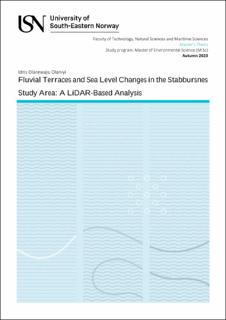| dc.description.abstract | This research work uses a LiDAR-based approach to map fluvial terraces, distinguish contemporaneous terraces, and decipher the complex link between sea-level fluctuations and terrace formations. The research aims to assess the efficacy of this strategy for larger applications. Through Mapping, I discovered a succession of six unique terrace levels (T1 to T6) in the study area, using Jenks Natural breaks categorization and mean elevation analysis. Terraces T1–T6 are thoroughly examined to reveal their kinds, formations, heights, sizes, and long-term stability, T1, T2, T3, and T4 exhibit fluvial features, T5 and T6, which are glaciofluvial in origin, hint at former glacial events. This study has discovered terraces that arose concurrently with its goal of understanding the temporal dynamics of terrace creation. This sheds light on the delicate interplay of forces that have guided their evolution throughout time. The findings contribute significantly to our understanding of terrace formations, glacial effects, and sea-level variations; all of this suggests that LiDar Data should be obtained wherever possible to increase the quality of geological mapping | |
